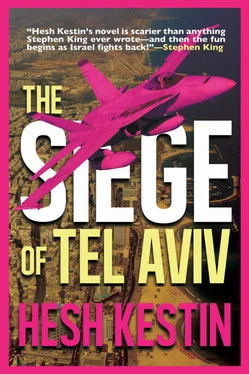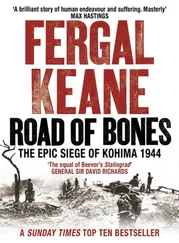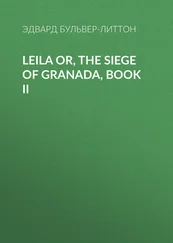From his office overlooking Ibn-Gvirol and—though he is not at the moment aware of it—his own son’s part in the operation, Yigal watches with Alon Peri as the choreography unfolds: IDF personnel sliding down the taut cables between the buildings, dropping to the tank roofs, inserting the brass tubes, striking them with hammers.
“How long will it take?” Yigal asks.
“Three,” Peri says, watching with him.
“Three what, minutes? That’s too—”
“Two,” Peri says. “One. Blastoff.”
In an operation that seems to have been designed by Busby Berkeley for a military training film—though minus the music—from one Jordanian tank to the next the same scene repeats: hatches fly open as the coughing, choking tank crews climb out, a good many falling off their tanks in a blind attempt to find clean air. Immediately, from storefronts and apartment house entryways, IDF soldiers sprint out to throw the retching tank crewmen to the ground and cuff their hands behind them with plastic ties. It is not so much a battle as a harvest.
While this is happening, IDF tank crews in gas masks enter the Challengers. These will be hot zones for at least an hour. Hatches open to air them out, the tanks move forward immediately, their new commanders riding above, for the moment able to remove their masks. What they see at street level is what the four Jordanian Apache pilots see from two thousand feet.
The empty boulevards swarm with people, a whole city come alive as the shelters empty. From the apartment house terraces, the white sheets are pulled down—one enthusiastic civilian even sets one alight, the flaming fabric falling to the street and nearly setting an IDF tank commander on fire. On every street, spontaneous dancing breaks out. Someone plays an accordion on his balcony. Here and there, as on the Jewish New Year, a ram’s horn sounds, a kind of tenor bellow, its pizzicato notes celebrating the joy of deliverance.
Then the Apaches drop down.
As one the celebrants look up, their happiness evaporating into fear as they stampede for cover. For dozens of civilians, it is too late—the Apaches’ twin 30mm machine guns plow through the crowd, spewing death in long lines like sewn seams as the helicopters swoop down the boulevards, aiming their Hellfire missiles at the tanks still bear the flying pennants of the Royal Jordanian Armored Corps. Two tanks are taken out immediately, their armor exploding in a wide radius, killing the tank crews and causing further civilian casualties.
But the attack does not last long.
From apartment house roofs, IDF infantry, among them a nine-teen-year-old red-haired girl sergeant who last used a Stinger missile a week earlier on the Tel Aviv beachfront, take them down with an efficient dispatch that is at once angry and professional.
Little is left of the Apaches other than their forty-eight-foot rotors, which spin off over the city until they crash into the tops of buildings and, in one case, fly through the windows of an office tower, some twenty feet of rotor blade sticking out into the still air like a flagpole. Later that day, an enterprising teenager will crawl out and attach to it the blue and white flag of Israel.
WHILE CLOSE TO TWELVE hundred captured tanks move eastward out of Tel Aviv in four columns, the sixty ex-Kuwaiti F/A-18s have already struck three significant targets: the Egyptian military field adjacent to what will soon enough return to being called Ben Gurion International Airport, the Jordanian field outside of Jerusalem that shortly will again be called Atarot, and a constellation of four smaller former IAF airfields in the north that were taken over by Syria and Iraq. In each case, most enemy aircraft are destroyed on the ground, black smoke from the planes and the asphalt burning beneath rising in columns that can be seen as far away as Cyprus. There casual observers note the fires before American intelligence specialists underground in the island’s British bases can detect it via satellite.
The few enemy pilots able to get their planes in the air take one look at the masses of Kuwaiti Super Hornets and decline to engage. All are pursued and brought down, some over enemy territory where anti-aircraft operations were terminated a month earlier. After all, Israel has no air force.
Under the command of General Ido Baram, the newly Israeli tank force is focused on seven distinct objectives:
[1] Pierce the wall of Syrian troops surrounding Tel Aviv that is meant to prevent its population from fleeing eastward;
[2] Bypass the Egyptian force waiting for Jordanian armor to secure the city so they can enter and begin cleansing operations, then prevent the enemy fleeing south and east, an IDF tactic first used in the Yom Kippur War to bottle up Egypt’s Third Army in Sinai;
[3] Secure the international airport so that food, medicines, and ammunition can be airlifted in;
[4] Punch through Syrian troop concentrations north of Tel Aviv to reach Israel’s main power station at Hadera, hard by the ancient Roman port at Caesarea, so that Israeli military engineers and civilian employees of the Israel Electric Company can reconnect its twin turbines to the power grid supplying Tel Aviv. The Iranian Revolutionary Guard commandos who moved in early to take over the power station are now outgunned. Those who do not die in battle are collected in Caesarea’s restored amphitheater, before the war a popular venue for concerts.
[5] Meanwhile, newly re-mechanized infantry is tasked to find the point where the pipeline bringing water from the north has been truncated and reconnect it. The effort fails until Persian-speaking interrogators identify an Iranian officer who knows the spot, and by two the next morning water begins to flow in Tel Aviv—brown at first, heavy with rust flushed from the unused pipes. By first light it is clear. To the people of Tel Aviv, no event of the past twenty-four hours is more significant. So many people bathe between 6 and 8 a.m. that in much of the city there is only a trickle. No one cares.
[6] Liberate six POW camps, four in the Negev, one close to Jericho, and one just outside of Netanya at Beit Lid, where a prison meant to hold twenty-two hundred convicted Palestinian terrorists now holds over thirty thousand Israeli prisoners of war. And zero Palestinians. These were summarily executed by the Jordanian muhabarrat . Indeed, as they move forward, Israeli intelligence officers are surprised to see no guerilla resistance from either Hamas or Hezbollah; only later does it become clear both Palestinian groups were early on massacred by their Muslim brethren in order to stifle any Palestinian claim to conquered Israel.
Conditions in the POW camps are horrific. Mass starvation, little to no drinking water, and lack of latrines have brought about an epidemic of typhus and amoebic dysentery. With no medical facilities on hand, and no medicines available to members of the IDF medical corps who fell into captivity, some 70,000 of the 380,000 Israeli prisoners have perished, the death rate multiplying up to and even past the hour of liberation. Because Arab prison camp commanders provided no facilities for burial, not so much as a shovel, bodies are found simply stacked up in corners of the camps to deteriorate in the sun. The stench is so bad the first tankists to arrive are forced to re-don their gas masks. Immediately, water taps in the Arab guard barracks around the camp are opened for the POWs—it is clear there is no shortage of water, merely a shortage of interest in keeping the Israeli prisoners alive. Those guards who have not fled face gruesome deaths as the skeletons in their charge take revenge.
It is a mark of how closely the camps resemble those of an earlier attempt to solve the Jewish problem that senior officers arriving on the scene turn their backs on the dismemberment of the guards. At one camp in the Negev, guards are executed next to the single tap available to the prisoners before liberation—the tap had been set up merely to drip water, so that the POWs were compelled to queue up for hours to receive the equivalent of a teaspoon each before returning to the rear of the long lines for their next taste. From captured documents, it is learned that reducing the flow to a trickle was meant to keep the death rate at manageable levels—were all the POWs to die at once, the mess might be visible from orbiting Western satellites.
Читать дальше












